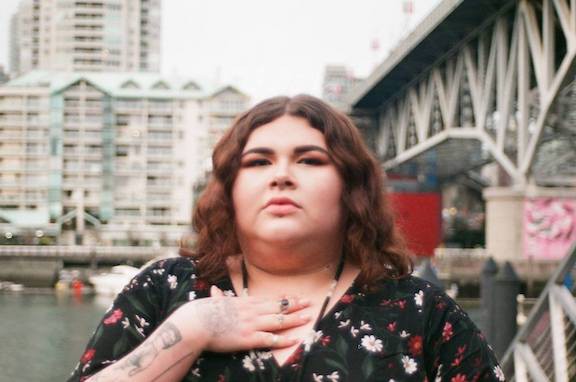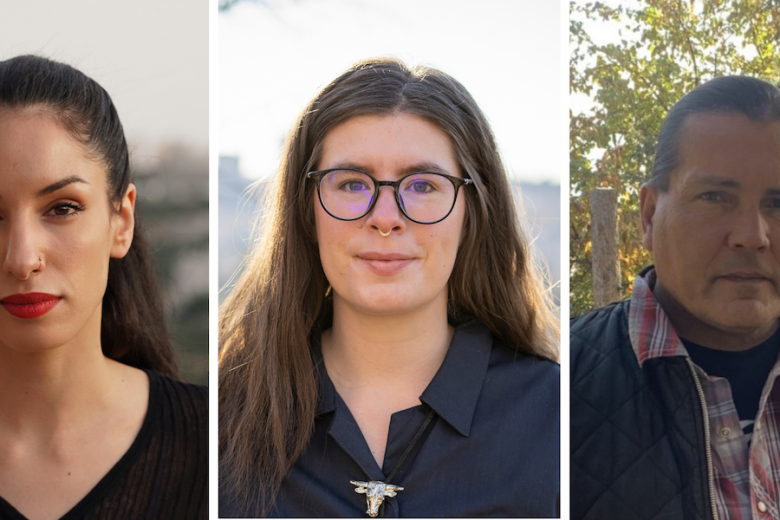Every year, Briarpatch hosts a contest where we invite our readers to submit poetry, photography, and creative non-fiction. It's one of the very few writing or art contests that explicitly focusses on social and environmental justice, and so it holds a special spot in Canada's literary and arts landscape. It's a lot of work to organize, but every year we are reminded by our readers that they're grateful for the challenging, sublime, and powerful art that we get to publish as a result.
This year, we have an extremely exciting panel of judges: Amber Dawn judging creative non-fiction entries, Jeff Bierk judging photography entries, and jaye simpson judging poetry entries. Briarpatch spoke to Amber Dawn, Bierk, and simpson about photographing encampments, envisioning queer Indigenous futures, and handling rejection.
You have until December 1, 2021 to enter the contest – details on how to enter are over here. It costs $25 to submit (which also gets you a one-year subscription to Briarpatch) and we have bursaries that allow 10 low-income artists to submit for free. Winners are published in Briarpatch Magazine and receive $500 in prizes; runners-up are published on briarpatchmagazine.com and receive $150.
Judges
jaye simpson is an Oji-Cree Saulteaux Indigiqueer from Sapotaweyak Cree Nation. Their debut collection of poetry it was never going to be okay won the Indigenous Voices Award for Published Poetry in English and was shortlisted for a 2021 ReLit Award and a 2021 Dayne Ogilvie Finalist. simpson resides on the unceded Musqueam, Squamish, and Tsleil-Waututh territories.
Jeff Bierk is a self-taught, multi-disciplinary artist, working with photography, sculpture, video, and paint. Born to the late artists Liz and David Bierk, he grew up in Peterborough, Ontario and learned the basics of photography and composition from his father. Jeff spent the majority of his teens and twenties lost to the opiate epidemic, addicted to OxyContin. He currently works for Anishnawbe Health, is a founding member of the Encampment Support Network, and is deeply committed to his community in downtown central east of Toronto. His work has been exhibited nationally, engaging themes that grapple with grief, addiction, homelessness, and settler colonial constructs of beauty and masculinity. Predominantly known for his portraiture, Bierk’s work poses serious questions about the ethics of street photography. Through a practice of collaborative photography, Bierk and his collaborators disrupt the formal definition and economics of photojournalism, and problematize the idea of the photographer as sole author of the photograph.
Amber Dawn is a writer and creative facilitator living on unceded territories of the Musqueam, Squamish and Tsleil-Waututh First Nations (Vancouver, Canada). She is the author of five books and the editor of three anthologies. Her memoir How Poetry Saved My Life: A Hustler’s Memoir (2013) won the Vancouver Book Award. She currently teaches creative writing at Douglas College, as well as guest mentors at several low-barrier, community-driven spaces.
Jeff, how do you navigate the ethics of photographing Toronto’s encampment community?
JB I first entered Toronto’s encampments at the beginning of the pandemic to support harm reduction efforts and frontline workers who were showing up when the city and police came in to clear encampment residents out. In those moments I had my camera – photography was a tool, a way to bear witness to the city’s violence.
A small group of us formed the Encampment Support Network and I started doing outreach in the Moss Park encampment six days a week. At the time, I didn’t have any real intention to document anything. It was only after months of showing up regularly that I pulled out my camera. By that time, people knew me well – to know me is to know someone that loves to photograph, to play with light and form, to share in the joy of the experience.
I’ve been thinking deeply and speaking about the ethics of photography for over a decade now and developed a practice based on transparency and enthusiastic, on-going consent. In Moss Park, the thing I’m always navigating is my own privilege and what that looks like. The people I photograph are my friends; we’ve been through things together that no one will ever know about, and the images I make are only meant to be expressions of the beautiful and reciprocal relationship we have – there’s nothing extractive about it. It’s true collaboration and the acts are simple – we dance together and make an image that’s primarily for us, and then there are many check-ins to make sure we all like the image and there is a clear conversation and more check ins about where the image is going and who will see it. For me, this kind of process is only possible through real and meaningful relationship.
Amber Dawn, you've taught non-fiction writing in a range of creative spaces – from university campuses to drop-in centres for sex workers. What are some common challenges you've seen while working with emerging non-fiction writers?
AD Writers acutely understand just how vast and complex their lives are and often feel responsible for capturing all of those complexities on the page. The “I” in nonfiction will never quite represent the whole “I” that we are in real life. It’s an impossible creative task – and one that I’ve seen make writers become stuck in an overwhelmed state. Celebrate the micro in the macro. There’s power in shorter, more focused personal narratives. Sometimes a single evocative scene can hold tremendous meaning for readers.
jaye, in the Indigenous Brilliance podcast and at the Victoria Festival of Authors, you’ve spoken about the power of queer, Indigenous futurisms. Can you share with us the futures you’re envisioning?
js I dream of the capitals falling, colonial buildings ablaze, bricks smoldering, and the utter fall of this colonial state with the focus on Land Back. I dream of chaos for the colonial forces and the destruction of the genocidal forces among us. But I also dream of love, joy, and happiness for my community. I see it in my friends’ smiles and hear it in our outrageous laughs. There is something so sacred about seeing us at the warehouse parties and book launches, on runways and movie screens. The world is forever changed and I want our lives to be honoured in all their many multitudes and nuances. We’re no longer in the vanguard, the barricades have been broken and we sure are killing the game aren’t we?
Rapid-fire round
What’s the first piece of art you can remember making?
JB My memory is so shot out. I have a large oil painting in my apartment from my childhood, I was maybe nine or 10, a Fantin Latour still life, but I don’t remember making it. Drawing at the kitchen table with my father, painting rocks.
AD Macaroni mosaics that depicted scenes from the Bible; sadly, not ironically. I grew up in an Italian Catholic community.
js I painted a picture of the seawall [in so-called Vancouver] in grade 2. It was hanging in some public school art show and I won a ribbon for it. One could say I’ve grown comfortable with winning since the second grade.
What piece of writing or art do you find yourself returning to year after year?
AD The short story “Speech Sounds” in Octavia Butler’s collection Bloodchild and Other Stories. In this story, the characters have to communicate survival needs and desires without the use of dialogue, therefore the physical action and sensory details are heightened.
JB My father’s paintings. They are one of the major ways I’m able to be in conversation with him long, long after his death.
js Madeline Miller’s Circe, Ben Rawluk’s “Plague Boy” and anything Eden Robinson. I enjoy my fantasy and have always hidden between the pages of many stories across many timelines. I love a story so rich and enthralling.
What do you think is overrated in writing or art?
JB The bar is low right now. I think most art is overrated.
js This is my own personal feeling, but ‘Instagram poetry’ often lacks constitution and, from time to time, reads very much like a Rae Dunn HomeSense find. If it got you into writing and poetry, I love that for you! That’s brilliant. Just not my cup of tea.
What do you eat a lot of when you’re working?
AD Microwave popcorn.
JB Miss Vickie's spicy dill pickle chips.
js Kraft Dinner and hot dogs!
What time of day are you the most creative?
JB Dusk.
js Whenever my estrogen hits, to be honest. Usually the few days after my injection I do a lot of work.
How do you know when you’re done?
AD I mostly write to deadlines now. I’m done when the deadline arrives.
JB That’s the hardest thing to know.
js Usually 60 seconds before the submission deadline.
A recent cause for celebration?
AD I’m celebrating 13 years together with my wife. In queer time, that very much makes us an old married couple.
js I just turned 27! I grew up being told I wouldn’t survive past 21 so every single year since is pure celebration surrounded by the people I love.
What’s your number-one tip for writers or photographers submitting to the contest?
AD Rejection (or not winning) is part of the process. Most of my published writing has been rejected at first, only to find another platform.
JB Be fearless! I second Amber Dawn: not winning is part of the process!
js My first publication included an essay I never ever ever thought would be picked. Have fun and know rejection is very normal, like Amber Dawn said!
Submit to the contest by December 1, 2021 – details on how to enter are over here.










